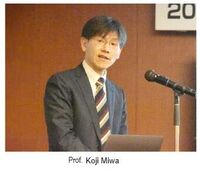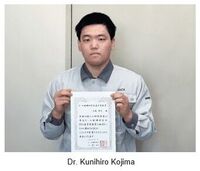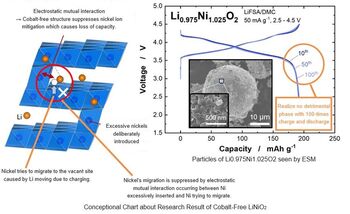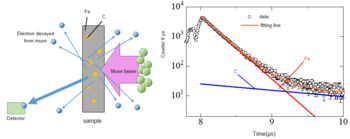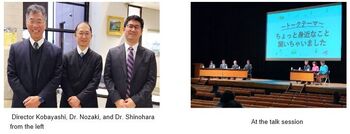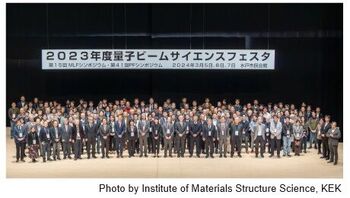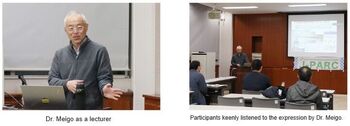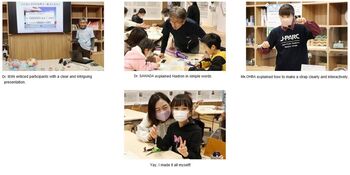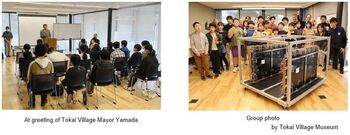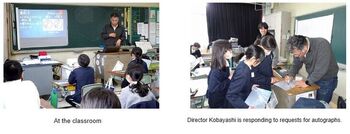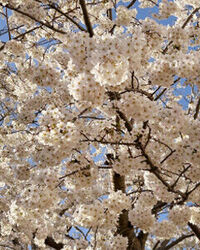J-PARC News March 2024 (Issue #227)
■Koshiba Prize by Foundation for High Energy Accelerator Science (March 7th)
Prof. Koji Miwa, a professor at the Graduate School of Science of Tohoku University and also a professor of KEK, was awarded the 2023 Koshiba Prize by the Foundation for High Energy Accelerator Science. This award is presented to researchers and engineers who have demonstrated outstanding creativity in the development of measurement technology in fundamental sciences such as particle physics and have gained international recognition.
Prof. Miwa has conducted research on hadrons and hypernuclei with Prof. Hirokazu Tamura and others at the J-PARC Hadron Experimental Facility. He was honored for pioneering the development of the hyperon-proton scattering experiment technique using the Recoil Proton Detection System (CATCH). This technique has led to significant contributions for theoretical research and is also expected to continue playing a vital role in the field of hadron physics in the future.
For more information, please visit the Institute of Particle and Nuclear Studies website.
https://www2.kek.jp/ipns/ja/news/5633/(only in Japanese)
■" Young Presentation Award" of The Japanese Beam Physics Club Youth Club, Young Researchers Group (March 6th)
Dr. Kunihiro Kojima of the Accelerator Division gave an oral presentation titled "Compensation of random resonance for further beam loss mitigation and beam power ramp-up in J-PARC RCS " and received the "Young Presentation Award".
This award aims to motivate young researchers and students engaged in beam physics research and to support their independence and professional development. His research findings, initiative, and coherent presentation were comprehensively evaluated.
■Developing Practical Nickel-Based Battery Material Balancing Higher Volumetric Energy Density and Cobalt-Free Structure
-Realizing Development of High-Performance Electrode Material by Controlling Structural Defect
A research group consisting of Yokohama National University, CROSS, and J-PARC, has developed a new Ni-enriched layered material, Li0.975Ni1.025O2, finding its potential as a high-volumetric-energy-density electrode material while maintaining a cobalt-free structure. The widespread use of lithium-ion batteries, particularly those containing cobalt in the form of LiCoO2, in electric vehicles reflects the pursuit of a low-carbon society. However, the geopolitical instability of cobalt resources poses a significant challenge.
This study extricated that Ni ion migration during charging caused aggravation of Co-free material. Moreover, the synthesis of samples including defects demonstrated the effective suppression of Ni-ion migration during charging.
These findings pave the way for the development of high-performance, practical, cobalt-free nickel-based electrode materials using a simple and cost-effective methodology.
For more information, please visit the J-PARC’s website.
https://j-parc.jp/c/press-release/2024/02/08001290.html (only in Japanese)
DOI: 10.1016/j.ensm.2024.103200
■Muon for Non-Destructive Analysis of Steel Archaeological Artifacts as Well as Quality Control of Steel Production
-Seeing Through Small Amounts of Carbon in Steel by Elementary Particle- (February 9th)
A research group from Osaka University, ICU, Kyoto University, KEK, JAEA, and National Museum of Japanese History developed a non-destructive measurement method by muon for scarce carbon included in steel.
Steel contains carbon, and its content determines its hardness. However, conventional carbon analysis methods cannot be performed nondestructively and have not been applied to cultural properties. The research group thought that it would be possible to analyze elements in materials by measuring the lifetime of muons trapped in the materials, and by using the high-intensity muon beam at J-PARC, they confirmed that quantitative analysis of trace amounts of carbon is possible using muon analysis and that the depth of muon irradiation can be selected.
This analysis method will lead to adding a new option for carbon analysis, in which destructive methods have been used. Moreover, the application is expected not only for the quality control of steel production but also for the analysis of precious archaeological artifacts such as Japanese sward. Furthermore, this method can be applied to other elements rather than carbon in steel in principle, being expected to diversify the application methods such as analysis of oxygen in metal.
For more details, please visit our website.
https://j-parc.jp/c/press-release/2024/02/09001291.html (only in Japanese)
DOI:https://doi.org/10.1038/s41598-024-52255-5
■International Advisory Committee 2024 (IAC 2024) Held (March 4, 5)
International Advisory Committee, operating under the "Fundamental Collaboration Agreement Regarding the Management of High-Intensity Proton Accelerator Facilities," serves as the superior committee overseeing four specialized subcommittees in the fields of accelerators, nuclear transmutation, neutrons, and muons. It convenes external members to deliberate on matters crucial to the operation, utilization, and facility development of J-PARC. Of the 16 committee members,12 from overseas and 4 from Japan, 14 attended the meeting, including Chairman Robert McGreevy, to discuss research and development activities at J-PARC for the fiscal year 2023 and to deliberate on recommendations for the years ahead.
During the parallel session, young researchers who will be responsible for the future development of J-PARC operations presented their recent research and development activities. At the reception held on the evening of the first day, Mayor Yamada of Tokai Village, KEK Director Haba, and JAEA Director Ohigawa participated and engaged in candid discussions regarding the future vision of J-PARC from their standpoints. On the final day, a tour of the Materials and Life Science Experimental Facility (MLF), Hadron Experimental Facility, Neutrino Experimental Facility, and MR Power Supply Building was conducted.
■Tokai Forum (February 21, Tokai Culture Center)
JAEA has been holding this forum as an opportunity to report the results of research and development and the progress of JAEA's projects to the local community. This year, the 18th forum was held under the theme of "Making Nuclear Power Closer".
Following reports on research into scientifically elucidating the taste of dried sweet potatoes and the development of protective mask glasses, Dr. Takenao Shinohara from the Neutron Science Section and Dr. Hiroshi Nozaki, an adjunct researcher at J-PARC Center, reported on their studies to improve the performance of fuel cells and Li ion batteries for automobile application.
By utilizing the neutron imaging technique at the RADEN instrument in J-PARC MLF, the inside of the cell, which is surrounded by a metal container, can be observed under its operation condition. This technique is employed to improve the performance of electric vehicles and to evaluate the safety of used lithium-ion batteries for their reuse and recycle, so as to contribute to the mitigation of global warming and the carbon neutrality.
For more information, please visit the Nuclear Fuel Cycle Engineering Laboratories website.
■FY2023 Quantum Beam Science Festa Held (March 5-7, Mito City Hall)
The 15th MLF Symposium and the 41st PF※ Symposium
The Quantum Beam Science Festa, aimed at providing a platform for information exchange between facility staff and users and for contemplating the future of quantum beam utilization research, is organized annually by the Institute of Materials Structure Science (KEK), J-PARC Center, Comprehensive Research Organization for Science and Society (CROSS), PF Users Association, and J-PARC MLF Users Society. At this year's event held from March 5 to 7 at Mito Civic Hall, on-site participants totaling approximately 470 exceeded the previous year, and lively discussions reminiscent of pre-pandemic times were conducted.
Following the PF symposium on the first day, two keynote lectures were given on the 6th: "Deep-Sea-Inspired Chemistry: A Materials Chemistry Approach to Sustainable Ocean Utilization " by Dr. Shigeru Deguchi of the Japan Agency for Marine-Earth Science and Technology (JAMSTEC), and "RIKEN Accelerator-driven Compact Neutron Systems RANS - Expanding use of neutrons and compact-scale-large-scale cooperation." by Dr. Yoshie Otake of RIKEN. In addition, parallel sessions in six fields and around 260 poster presentations were demonstrated. The 15th MLF Symposium on the 7th consisted of two parts, "Road to 1 MW" and "Road from 1 MW," providing an opportunity to review the path of facility development to date and to discuss the roadmap, the futuristic scheme for MLF, with the parties.
For the first time in five years, a reception was held with a toast by Tokai-mura Mayor Yamada, providing an opportunity to exchange opinions on interdisciplinary fusion.
※Photon Factory, Institute of Materials Structure, KEK
■J-PARC Hello Science
"Plan for Nucleon Engineering Facility to Contribute to Human Society - toward Medicine, IoT, and Space." (February 22nd)
In this month’s Hello Science, Dr. Shin-ichiro MEIGO of the Nuclear Transmutation Division introduced the new development of the planned nucleon engineering facility at J-PARC.
At J-PARC, the construction of this new facility aims to establish technology capable of efficiently converting high-level waste from reactors into less harmful nuclei by generating neutrons from accelerated protons. The new facility is designed not only for developing beam windows of the target to establish nuclear transmutation technology but also for conducting multipurpose experiments utilizing a wide range of proton and neutron energies. Furthermore, its utilization of the existing Linac enables cost-effective and swift construction, which is a notable advantage.
Once operational, this facility will address versatile needs, including irradiation experiments for material research, the production and stable supply of medical isotopes, and simulating space environments, which are currently reliant on overseas facilities for domestic research. This planned facility, resembling a fusion of a nuclear reactor and an accelerator, holds potential for applications not only in nuclear transmutation technology but also in diverse fields, heightening expectations for further advancements.
■J-PARC Workshop: "Let's Make Accessories with Hadron" Held (March 9th, Science Museum, Hitachi Civic Center)
Dr. IEIRI Masaharu from the Particle and Nuclear Physics Division introduced research on hadrons conducted at J-PARC. Following his presentation, a workshop was held where participants used beads resembling hadrons to make straps. We had 44 participants and received feedback from them, with comments such as "I had never heard of 'hadrons' before, so I joined to learn more" and "Hadrons are so mysterious." It's pleasing for the staff to see attendees taking an interest in J-PARC's research. Conversations between participants and researchers were lively, creating a warm atmosphere throughout the workshop.
■"Muographic Investigation of Ancient Burial Mounds in Tokai" Project in 2023 Closing Ceremony (March 17)
As part of the project activities aimed at utilizing cosmic ray muons to see through the Funatsuka Ancient Burial Mounds No. 2, a muon detector, which has been collaboratively developed with 25 elementary, junior high, and high school students since October last year, completed its construction. A closing ceremony was held to commemorate this achievement. Nineteen participants attended the ceremony, where Tokai Village Mayor Yamada presented the children with certificates of completion at the Tokai Village Museum.
Following the closing ceremony, Dr. Yutaka Tanaka from Ibaraki University provided insights into how the shape of ancient burial mounds evolved during the three major periods of the Kofun period (Early Period, Middle Period, and Late Period). Using survey maps, the children determined the period to which the shape of Funatsuka Ancient Burial Mounds No. 2, slated for muon perspective, belongs. Under the guidance of Dr. Yoshiaki Fujii from J-PARC, the completed muon detector was put into operation. The children observed cosmic rays penetrating the Tokai Village Museum, marking the conclusion of all activities for this year.
The detector, affectionately named "Detector for History and Future " through a voting process, will be installed in Funatsuka Ancient Burial Mounds No. 2 next fiscal year, marking the beginning of seeing through the tomb.
■The 13th Koshien of Science National Competition (March 15-17, Tsukuba)
The Koshien of Science National Competition, in which high school students from representative schools in each prefecture compete in the proficiency of science, took place over three days from March 15th to 17th at the Tsukuba International Congress Center and Tsukuba Capio.
This year marked the 13th edition of the competition, returning as a regular event at the first time in four years. As a large audience looked on, participating students tackled their experiments while adapting to unexpected challenges. The conclusion of each competition session was met with resounding applause.
On the final day, March 17th, following the awards ceremony, 194 high school students visited the exhibition booth set up by the J-PARC Center. There, they received explanations about the J-PARC accelerator and experiments conducted using J-PARC from Dr. Susumu Igarashi and Dr. Kazami Yamamoto of the Accelerator Division, Dr. Mifuyu Ukai of the Particle and Nuclear Physics Division, Dr. Takeshi Yamamoto of JAEA's Advanced Science Research Center, as well as two students engaged in hadron experiments: Kengo Ebata, a first-year doctoral student at Kyoto University, and Ryo Imamoto, a first-year master's student at Tohoku University.
The J-PARC booth was a great success through the event, with high school students showing keen interest in the diverse fields of physics explored at J-PARC, ranging from condensed matter to elementary particle nuclei. They attentively listened to explanations from researchers and university students of their generation, posing numerous questions about research topics and career paths, including inquiries about pursuing a career in research.
■Director Gives a Lecture at Ochiai Elementary School in Maniwa City, Okayama Prefecture (March 8)
Takashi Kobayashi, the Director of J-PARC, visited Ochiai Elementary School in Maniwa City, the school he attended in his youth, to deliver a lecture titled "Secrets of the Big Universe, Secrets of the Microscopic World, and Accelerators."
Twenty fifth-grade students participated in the interactive session, which included quizzes on topics such as the scale of the universe, the microscopic world, and research conducted at J-PARC, resulting in an enjoyable and educational experience.
■J-PARC Sanpomichi ㊹ -Someiyoshino and J-PARC-
Someiyoshino is used to predict the blooming of cherry blossoms. Someiyoshino cannot reproduce, so the only way to increase their numbers is through grafting or cuttings. All Someiyoshino in Japan are clones made from the same genes. When external conditions such as temperature align, every flower blooms and sets the standard for flowering.
It is said that the scattering of Someiyoshino petals is particularly beautiful. The spectacle, especially when a strong wind causes a profusion of petals to fly in the same direction, evokes the flow of particles at J-PARC. J-PARC accelerates an enormous number of protons to create a vast array of particles including neutrons, K mesons, muons, and neutrinos, aiming to delve into the origins of the universe, matter, and life. However, the staff members involved in creating, accelerating, and analyzing particles are individualities with each trait far from clones.
January has gone, February has fled, and March is on its way out. The staff members transferring to J-PARC in April likely won't have room in their minds for indulging in cherry blossom viewing sentiments as they compile their past activities and prepare handover documents. From April onwards, the incoming J-PARC staff will bring fresh perspectives, aiming to operate this massive experimental facility safely, enhance its performance, and generate new research outcomes. Likewise, it is hoped that those departing from here will be able to fully utilize the skills and qualities they've developed at J-PARC in their new environments.

